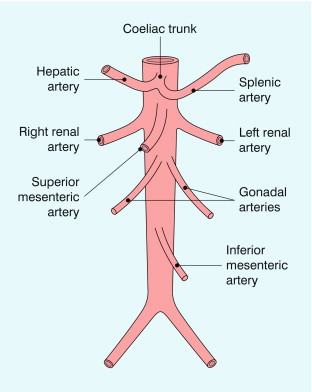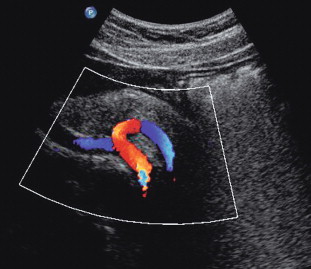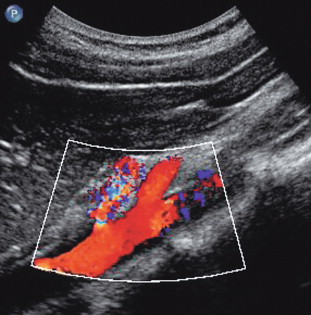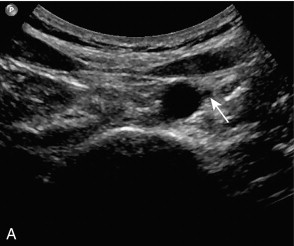Physical Address
304 North Cardinal St.
Dorchester Center, MA 02124
Doppler examination in the abdomen is associated with specific problems which are not encountered in peripheral vascular examinations and these are particularly relevant to examinations of the aorta, inferior vena cava and their associated vessels.
Respiratory motion and cardiac pulsation impair the examination, but getting the patient to suspend respiration for any length of time results in relative hypoxia and subsequently increased respiratory movement. It is therefore better to scan as much as possible during quiet respiration, asking the patient to hold their breath only for short periods in order to obtain a spectral trace. In most cases only two or three cardiac cycles are needed for assessment.
Many vessels will always seem to be orientated at right angles to the scan plane, especially with sector or curved linear transducers. Different angles of approach and repositioning of both the transducer and the patient may be required in an attempt to improve the Doppler angle.
Bowel gas is also a problem as it can obscure a vessel, or produce distracting motion artefacts as it bubbles past; scanning after an overnight fast may improve the situation, as may an injection of hyoscine. It has been suggested that patients should receive bowel preparation as for an enema, but this author feels that this is not usually justified for the small advantage it may occasionally confer.
Abdominal Doppler examinations are performed on vessels which lie more deeply than the peripheral vessels and this has several consequences. First, lower-frequency transducers are used and this limits the size of Doppler shift which will be obtained for a given velocity. Second, longer-pulse repetition intervals are required to allow the sound to travel the greater distances; this also limits the size of Doppler shift which can be measured as a result of the Nyquist limit (see Chapter 1 ). Operators should therefore seek to minimise the scan depth and use the highest-frequency transducer compatible with adequate visualisation.
The aorta enters the abdomen at the level of T12 and runs down the posterior abdominal wall to the left of the midline, with the inferior vena cava to its right side. It divides into the common iliac arteries at the level of L4, which is about the level of the iliac crests. Para-aortic nodes are distributed anteriorly and on both sides of the vessel.
The abdominal aorta gives branches to the abdominal organs and to the abdominal wall. The parietal branches to the abdominal wall are not usually large enough to be seen regularly using colour Doppler and will not be considered further. The visceral branches ( Fig. 6-1 ) supply the liver, kidneys, adrenal glands, gonads, spleen, bowel and pancreas. The vessels to the adrenals and gonads are also usually too small to be seen reliably on ultrasound; the renal, hepatic and iliac arteries are covered elsewhere in greater detail.

The splanchnic arteries supply the bowel and associated organs. The coeliac trunk ( Fig. 6-2 ) arises from the anterior aspect of the aorta just after it has entered the abdomen. The trunk is only about 1 cm long and divides into three branches: the common hepatic artery, the splenic artery and the left gastric artery. The common hepatic artery passes to the right over the head of the pancreas, where it gives off the gastroduodenal artery which can be seen passing inferiorly between the head of the pancreas and the margin of the duodenum; the other branches from this segment of the hepatic artery are not usually apparent on ultrasound. The artery ascends in the lesser omentum as the proper hepatic artery, in company with the portal vein and common bile duct, to the porta of the liver, where it divides into right and left hepatic arteries. The splenic artery passes to the left and runs along the superior margin of the body of the pancreas to the hilum of the spleen. It has a tortuous course and an arterial loop may be mistaken for a small cyst in the pancreas if the situation is not recognised; colour Doppler allows quick identification of the true nature of the ‘cyst’. The right gastric artery arises from the splenic artery but is not usually seen on ultrasound.

The superior mesenteric artery ( Fig. 6-3 ) arises 1–2 cm below the coeliac trunk and supplies the small bowel and colon to the distal transverse colon. The superior mesenteric vein is seen on the right side of the upper portion of the artery and can be followed to its confluence with the splenic vein, forming the portal vein. The individual branches of the superior mesenteric artery are not usually seen clearly on ultrasound. The inferior mesenteric artery ( Fig. 6-4 ) arises from the anterior aorta about 3–4 cm above the bifurcation and runs inferiorly to the left side of the aorta. The inferior mesenteric vein may be seen on the left of the artery but diverges as it passes up to join the splenic vein.


Several variations in the anatomy of the splanchnic arteries are well recognised. The most important one in relation to ultrasound is the origin of the right hepatic artery from the superior mesenteric artery. Occasionally the coeliac trunk is absent with its branches arising separately from the aorta; the left hepatic artery may arise from the left gastric artery and accessory hepatic arteries may arise from the superior mesenteric artery or other arteries in the region.
The upper abdominal aorta can nearly always be examined through the left lobe of the liver; the coeliac trunk and superior mesenteric arteries are also visible from this approach. A 3 or 5 MHz transducer is used depending on the build of the patient. The patient should fast for 8 h prior to the examination, for two reasons: first, fasting will improve visualisation of the aorta and its branches; second, splanchnic blood flow will be in the basal fasting state, rather than the dynamic postprandial state.
If the aorta is the main object of the investigation it is followed distally to its bifurcation. The vessel should be scanned both longitudinally and transversely, taking note of the overall diameter, the presence of any aneurysmal dilatation and any para-aortic masses or pathology. If visualisation from an anterior approach is impaired, then scanning in a coronal plane through the right lobe of the liver will allow the upper aorta to be visualised; scanning in a coronal oblique plane from a left posterolateral approach can provide a view of the mid- and lower aorta, together with the bifurcation. The calibre of the vessel used to be measured from the outer aspect of the vessel wall, ideally during systolic expansion. However, it has been shown that measurement of the systolic diameter between the inner aspects of the vessel wall is a more repeatable measurement to make and this is therefore used for follow-up of aneurysm patients. It is important to ensure that the true anteroposterior diameter is measured, particularly in ectatic, tortuous arteries, as oblique measurements will result in falsely high measurements. Colour Doppler and spectral Doppler are used to assess any potential disturbances of flow which may result from atheroma or dissection.
Become a Clinical Tree membership for Full access and enjoy Unlimited articles
If you are a member. Log in here